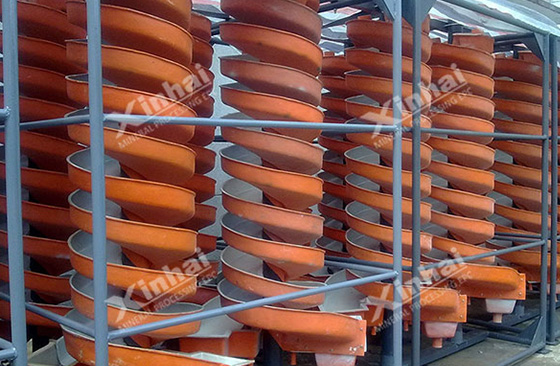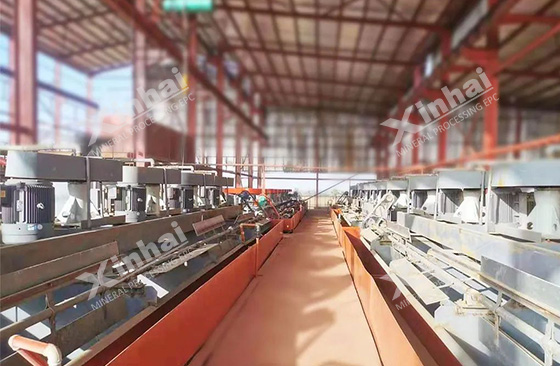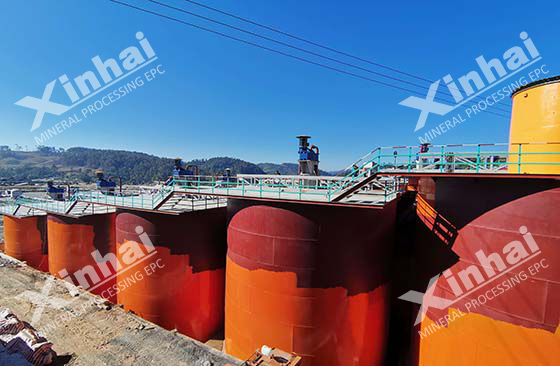
Gold and copper minerals are found in different geological environments such as porphyry deposits, skarns and other deposit-forming environments. Common gold and copper minerals include chalcopyrite, bornite, cuprous sulfide, stibnite, tellurium gold ore (AuTe2), etc. These minerals are important sources of gold and copper. The presence of gold in copper ore deposits can significantly increase their value, and it is often economically advantageous to recover both metals simultaneously. In these deposits, the specific mineral composition and distribution of gold and copper can vary greatly depending on the geological body, so it is necessary to select appropriate ore beneficiation technology to improve the recovery rate of copper and gold. The following will introduce you to the gravity separation and flotation beneficiation technology of gold and copper ores.

(Gold ore)
Gravity separation typically separates gold and copper minerals based on their different densities. The ore is broken into fine particles, and gravity separation equipment is used to separate the heavy metal gold particles from the light metal copper minerals. Once the gold and copper minerals are separated, they are usually collected in separate containers. The gold particles are usually located at the bottom or bottom layer of the gravity separation equipment, while the copper minerals are in the upper part or upper layer. The collected gold and copper minerals are called concentrates, while the unseparated portion is called tailings. The concentrate typically undergoes further processing to improve gold and copper grades. Tailings may be processed or stored to reduce environmental impact.

(Spiral chute)
Common gravity mineral processing equipment:
Jig machines use water flow and vibration to separate gold and copper minerals. Because gold is heavier than copper, gold particles usually settle to the bottom, while lighter copper minerals float upward.
The spiral chute separates the ore into different density layers through a rotating spiral channel. Gold and copper minerals are deposited at different locations in the spiral.
Centrifuges use centrifugal force to separate gold and copper minerals. Due to their different densities, gold and copper are separated in a centrifuge.
Gravity separation of gold and copper minerals is an effective ore beneficiation method, especially suitable for ores with obvious density differences. However, for some more highly mixed ores, it may be necessary to use other beneficiation methods, such as flotation or chemical leaching, to separate gold and copper more effectively.

Flotation relies on the difference in mineral surface properties. During flotation, chemical reagents are added to form foam, which selectively attaches to gold or copper minerals, thereby achieving their separation. Flotation can be a complex process that requires multiple stages to effectively separate and recover the two metals. First, the gold and copper ore is crushed and ground to refine its particles. Then, a variety of chemicals are added to the slurry to change the properties of the mineral surface. Afterwards, air are injected into the flotation cell to generate bubbles. These bubbles attach to gold or copper mineral particles and float them to the surface of the flotation cell. As the flotation process proceeds, the gold and copper minerals form scum or concentrated products, which can be collected and further processed.

(Flotation agent foaming agent)
Collectors are surfactants that can be adsorbed on the surface of gold or copper minerals, giving them an affinity for air bubbles. For gold minerals, commonly used collecting agents include buxone and chalcopyrite. For copper minerals, sulfurizing agents are usually used.
Frothers are added to the flotation cell to help generate and stabilize air bubbles. Common foaming agents include detergent and glycerin.
Adjusters can optimize the flotation effect by adjusting the pH value in the flotation tank. Different minerals respond differently to pH.
Flotation separation is an effective method to separate gold and copper minerals in different ores. The success of flotation is related to agent selection, tank design, operational control and ore characteristics.

(Gold Mine Concentrator)
The above is the gravity separation and flotation separation technology of gold-copper ore. The specific process design, equipment and chemical selection should be based on the ore properties and production requirements of gold-copper ore. In production, continuous optimization of the mineral processing process can improve the recovery rate of gold and copper and the ore grade. Gold-copper ore beneficiation technologies include magnetic separation, leaching, etc. The appropriate mineral separation technology should be selected based on the needs to avoid capital losses and resource waste.
To find out more about our products and solutions, please fill out the form below and one of our experts will get back to you shortly.